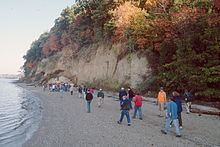Type sedimentary Other shells | Named for Yorktown | |
 | ||
Sub-units Sunken Meadow Member, Rushmere Member, Morgarts Beach Member, Moore House Member, Tunnels Mill Member Region Atlantic Coastal Plain of North America | ||
The Yorktown Formation is a mapped bedrock unit in the Coastal Plain of Maryland, Virginia, North Carolina and South Carolina. It is overconsolidated and highly fossiliferous.
Contents
Description
The Yorktown is composed largely of overconsolidated sand and clay with abundant calcareous shells, primarily bivalves.
Stratigraphy
The Yorktown unconformably overlies the Miocene Eastover Formation, and conformably underlies the Pliocene Croatan Formation.
The Yorktown was divided into members by Ward and Blackwelder (1980). These are in ascending order: Sunken Meadow Member, Rushmere Member, Morgarts Beach Member, and Moore House Member. The uppermost Tunnels Mill Member is recognized in Maryland only.
Fossils
Notable Exposures
Age
Hazel (1971) revised the age of the Yorktown from Miocene to Late Miocene to Early Pliocene using ostracod biostratigraphy. The age was revised by Gibson (1983) to extend into the Middle Pliocene based on foraminifera. Further biostratigraphic work with ostracods and foraminifera was completed by Cronin (1991), which also summarized previous investigations.
